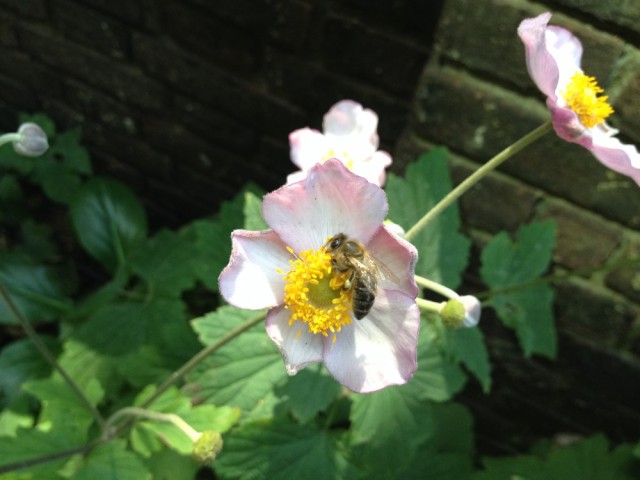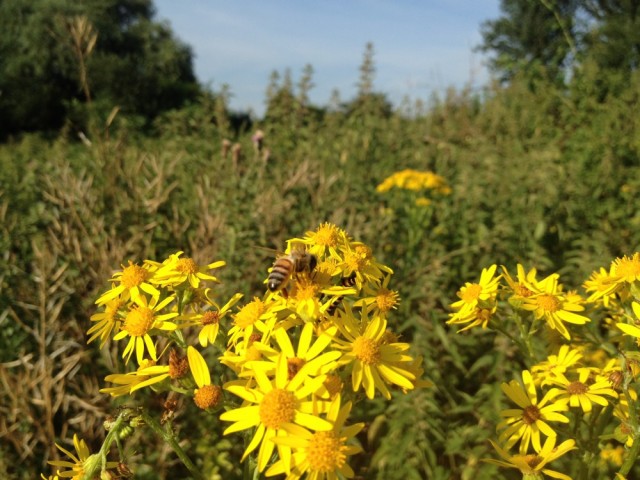I felt so lucky to be heading down to the apiary in glorious heat today. I know a lot of people don’t like this hot weather, and I’m sorry about that, but I have to admit I love it. We’ll have plenty of rain, wind, frost and storms ahead in the autumn and winter for you cold weather lovers I’m sure.
Last week I had a photo of Brian’s clever top-bar hive design in my post ‘Bees, honey, flowers, cake and a party‘. Today you can see him cutting into the hive like a cake. What he’s doing here is cutting down around the edges where the comb has been fixed to the hive walls, so he can lift the comb out and inspect it. The little cluster of bees you can see on top are gathered round the space where the bees go up into the super, which he’s lifted off before inspecting.
I love the shape of these combs, like bunting or flags. The bottom corner of the triangle wibbled as he lifted each one out. As top-bar hive combs don’t usually have a wooden bottom and sides, they tend to be more delicate than National hive combs. However people who are good at wood working can choose to provide them with a hollow frame tailored to the size of their top-bar hive, to make the comb sturdier.
Unfortunately there was no sign of eggs or uncapped brood in the colony. Just plenty of honey, pollen and some capped brood.
Here Brian is blowing on the bees to try and move them out of the way so he can check for eggs. He didn’t find any but he could give them eggs from another top-bar hive he has.
By the way all the time he was inspecting we had some live African style tribal music coming from the Mencap centre next door. It had a lot of rhythmic drumming that made me want to dance. Who knows what effect it had on the bees, I was concerned it might whip them up into a frenzy but bee business continued as usual.
This is a photo I took of myself in my bee suit before inspecting our four hives. Afterwards I was far too tired and sweaty to be taking any photos. I’m using surgical style gloves at the moment but they get uncomfortably sticky and clingy very quickly. It feels great to rip them off and inspect bare handed, except then my hands get covered with yellow propolis. Also the feeling of the bees on my bare hands is a little distracting.
All was well inside our new queen Pepper’s hive, with lots of eggs. They have drawn out a few of their super frames. I don’t expect to harvest anything from that hive, but am hopeful they might complete the super by late autumn with the ivy flow, giving them good winter stores. Chili’s hive is in a pretty similar situation.
Worryingly I spotted a poor bee with useless shrivelled slivers of wings in Chamomile’s colony, a sign of deformed wing virus (associated with varroa). I thought I also saw a mite on a drone’s back. And in Chili’s colony I saw workers chasing a black and shiny hairless worker – a symptom of chronic bee paralysis virus (CBPV), also associated with varroa. We shall be doing Apiguard treatment on all our colonies in August.

A drone in love with Emma – he stayed on her hands fanning himself on Tuesday evening while she inspected several frames.
Last week Emma wrote about our favourite colony, previously headed up by Queen Myrtle, in her post Pink queens and a swarm? Sadly it seems our most gentle queen is no more. As the colony had produced queen cells, I am desperately hoping one of her daughters is in there and will begin laying soon. There was no sign of eggs this week, so I tried putting a frame of eggs from Chamomile’s hive in there, as a test. If they make queen cells from it, that suggests they’re queen-less. If not, hopefully all is well and a daughter of Myrtle will mate and begin laying soon.
My reason for particularly liking Myrtle’s bees are that they are the direct descendants of a colony which was kindly given to me and another Emily by a Ealing beekeeper named Ann Fox six years ago. Since then the colony has made itself new queens most years, but they are all ancestors of that original colony and queen. They’re lovely bees – absolutely nothing phases them – and have been very productive this year too. So fingers crossed Myrtle’s genes live on.








Darn that varroa. I hate reading of all the nasty side effects – like having an animal suck your blood isn’t bad enough. I am praying that the clever scientists come up with something better than apiguard before varroa lands in Australia. I hope your treatment in August works and your colonies are healthy again for spring.
LikeLike
Thanks Laura. Apiguard is over 90% effective when done in the right conditions – hive taped up, warm weather – but of course you only use it once a year. We have to use a whole variety of methods, some non-chemical, during the year to keep on top of things. Hope varroa arriving in Australia is a long way off yet.
LikeLike
Having a brood break has been found to be effective in lowering varroa numbers. Remove the queen and all frames with eggs and larvae at beginning of July and put in a new hive box or a nuc box.Leave all capped brood in the parent hive. The parent hive will make a new queen and she will be laying in about 34 days.The break makes it impossible for the varroa to find uncapped cells to enter and breed in.
LikeLike
Thanks Tony. Usually we shook-swarm the bees in March or April so that there’s a brood break then. Unfortunately Chamomile’s hive was too weak to shook-swarm though.
LikeLike
Very nice . . . lots of bees all over the place here. A welcome change from last year when I thought we were seeing a drop in the number of bees hitting the Chives, Salvia, Russian Sage, and Bluebeard bush.
LikeLike
Great news. Your garden must be a bee haven as well as a hummingbird hotel.
LikeLike
Reblogged this on Linda's wildlife garden and commented:
THANK YOU FOR SHARING HAVE A BLESSED DAY
LikeLike
Thank you Linda!
LikeLike
Such lovely photographs! I hope all this hot weather keeps the flowers happy and the nectar supply up. It is such a clever way to find if the hive is queenless, I do hope there is a new queen in there ready to start laying. Amelia
LikeLike
Thanks Amelia, I’ll be in Scotland next week but Emma will be taking a look to see what they do with the eggs.
LikeLike
You look so cute in your bee suit. I think I would have melted in the heat, got cranky and the bees would have sensed my displeasure. I am glad you explained why you have a favorite colony. I just look at bees as all the same and reading your posts have learned they have different dispositions. Nice you have different generations in that hive. It does make it special.
LikeLike
Thanks. Yes, bee colonies can have very different moods and ‘personalities’. It can be quite startling how some colonies will walk slowly and calmly on their combs, whereas others will race around like mad.
LikeLike
I came here after reading the post of A Tramp in the Woods where he recommended you ! I’ve learn al lot reading his blog and yours looks very interresting as well and look forward to learn new stuff !
LikeLike
That was nice of him, I like his blog too. And yours is stunning. I’ve been to Borneo recently for my honeymoon, how did you find it? I have some photos from our visit at https://adventuresinbeeland.com/2014/06/05/beasts-of-borneo/
LikeLike
I find it very humid and hot ! I didn’t have time to publish about it yet, but I’ll try to upload some pictures soon. I’ll have a look at your entry, thanks for the link !
LikeLike
What a great looking top bar! I tried out my first top bar this year, and I’ve had no luck whatsoever. Not sure what is going on, but I just could not get that hive to take off. They are currently queenless with less than four tiny drawn bars, no honey, no brood, and no pollen. At this late stage, the only hope is maybe to shake the fee stragglers into a hive and combine, but there’s only maybe 1,000 left. I don’t know if it is worth it.
LikeLike
It’s sad when that happens. Sometimes a colony being slow to build up can be caused by nosema.
LikeLike